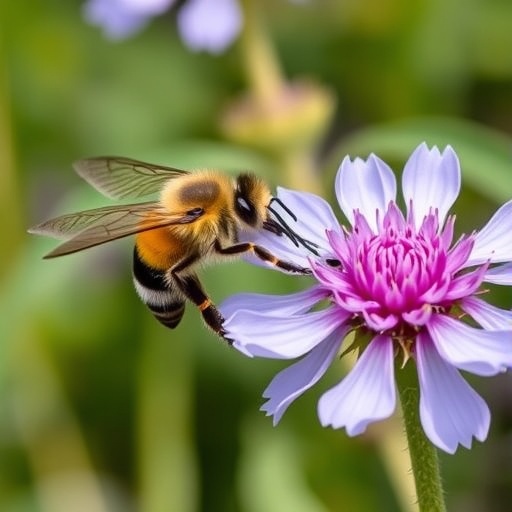In a groundbreaking study conducted by researchers at the University of Würzburg in collaboration with the Bavarian State Institute for Agriculture, new insights have emerged regarding the role of biodiversity in enhancing pollinator populations and stabilizing crop yields. Focusing on sunflower fields in northern Bavaria, the research team explored how different farming practices and landscape configurations influence wild pollinator dynamics and, subsequently, agricultural productivity. This comprehensive field study, encompassing 29 sunflower plots—divided between 15 organic and 14 conventional farms—offers pivotal data illuminating the nuanced interplay between organic farming, habitat preservation, and pollination efficacy.
The investigative approach utilized by the scientists was both innovative and straightforward: sunflower heads within test plots were either shielded from pollinator access by fine mesh nets or left exposed to natural pollination. This experimental design allowed for a clear quantification of the direct impact of insect visitation on seed production. Remarkably, the results demonstrated that sunflowers subjected to natural pollination consistently produced yields approximately 25% greater than those protected from pollinators. This yield increase was independent of whether the fields were managed organically or conventionally, highlighting the critical importance of biotic pollination across agricultural systems.
Delving deeper, the researchers discerned distinct responses among different pollinator taxa based on their ecological requirements and sensitivities. Bumblebees, for instance, showed a pronounced affinity for landscapes enriched with a higher proportion of organically farmed fields. Quantitative analyses revealed a near doubling in bumblebee population density as the share of organic acreage rose from 10% to 20%. This correlation suggests that organic farming practices create more favorable conditions, such as reduced pesticide exposure and enhanced flower diversity, which cater specifically to the life history traits and foraging behaviors of bumblebee species.
Conversely, solitary bees exhibited a divergent dependency pattern, with their abundance closely linked to the availability and extent of semi-natural habitats. Features such as hedgerows, calcareous grasslands, and traditional orchards emerged as critical refuges and nesting sites for these pollinators. The spatial configuration and preservation of these elements within the landscape matrix proved essential for sustaining solitary bee populations, which possess unique nesting ecologies distinct from social counterparts like bumblebees and honeybees.
This study also underscores the broader ecological principle that biodiversity and agricultural productivity are not mutually exclusive but rather symbiotic. By fostering heterogeneous landscapes that integrate both organically managed farmland and well-conserved semi-natural habitats, agricultural systems can optimize ecosystem services such as pollination. This multifaceted approach not only promotes a richer pollinator community but also enhances the resilience and stability of crop yields under varying environmental conditions.
Importantly, the research findings challenge conventional paradigms emphasizing monoculture expansion and intensive land use by illustrating potential pitfalls. Specifically, the scientists caution against creating excessively large homogeneous flowering areas, which can inadvertently dilute pollinator activity. When too many identical crops bloom simultaneously over vast tracts, pollinators become dispersed, reducing effective visitation rates per plant and diminishing overall pollination efficiency. This dilution effect highlights the necessity of maintaining spatial and temporal crop diversity within agricultural landscapes.
Moreover, the investigation revealed an unexpected yet pragmatic role for moderate weed presence in crop fields. Rather than viewing weeds solely as yield-competing nuisances, the study demonstrated that low-to-moderate weed densities can provide critical additional nectar and pollen resources for wild bees and hoverflies, thereby supporting their populations without significantly compromising sunflower production. This insight advocates for balanced weed management strategies that integrate ecological benefits with agronomic objectives.
The study’s sophisticated design, which integrated field-level variables with landscape-scale analyses, offers a comprehensive framework for understanding how farming practices influence pollinator ecology. Through robust statistical modeling, the researchers isolated the relative contributions of organic farming proportions, habitat heterogeneity, and weed prevalence, painting a detailed picture of multifactorial influences on pollination services. This methodological rigor enhances the study’s applicability across diverse agroecological contexts beyond Bavaria.
From a practical standpoint, the research provides actionable recommendations tailored to farmers, policy-makers, and conservationists aiming to harmonize agricultural productivity with biodiversity conservation. Scaling up organic farming within regions can amplify pollinator numbers, which in turn benefits both organic and adjacent conventional fields through enhanced pollination spillover effects. Simultaneously, safeguarding semi-natural habitats within farmlands ensures the survival of critical solitary bee species whose ecological niches cannot be fulfilled solely within cropped areas.
Crucially, these findings contribute to a growing body of evidence supporting landscape-level approaches to agricultural sustainability. They emphasize that individual farm practices, while important, must be contextualized within broader territorial planning frameworks that balance production goals with ecological stewardship. This integrated perspective aligns with contemporary agroecological paradigms aiming to reconcile food security with environmental conservation.
The funding and organizational support behind this study were provided by the Federal Ministry of Food and Agriculture (BMEL) and the Federal Office for Agriculture and Food (BLE) in Germany, reflecting strong institutional commitment to advancing sustainable agriculture through science-based policy guidance. This exemplifies how governmental frameworks can leverage academic research to inform land-use strategies that underpin food system resilience.
In conclusion, this in-depth investigation from northern Bavaria elucidates the complex interdependencies between organic farming, landscape heterogeneity, and pollinator communities. By revealing how distinct pollinator groups differentially respond to farming and habitat variables, the study advocates for diversified agricultural landscapes that support wild pollinators, bolster yields, and promote long-term agroecosystem stability. These findings not only advance scientific understanding but also offer a strategic blueprint for future agricultural and environmental policy development worldwide.
Subject of Research: Effects of landscape-scale organic farming and habitat structure on wild pollinators and agricultural yields
Article Title: Wild pollinators and honeybees respond differently to landscape-scale organic farming and increase sunflower yields
Web References: 10.1111/1365-2664.7015
Image Credits: Image by Valentina Vey
Keywords: Organic farming, wild pollinators, bumblebees, solitary bees, sunflower yield, biodiversity, landscape ecology, pollination services, sustainable agriculture, habitat conservation, agroecology, ecosystem services




